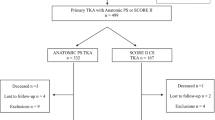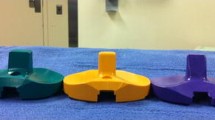Abstract
Background
Total joint arthroplasties of the hip and knee represent a remarkable feat of modern medicine in terms of reducing pain and restoring function to millions of patients afflicted with severe arthritis. Oftentimes, the performance and longevity of new implants and devices are based on limited data. This is the first study by a non-designer on the press fit condylar rotating platform posterior stabilized (PFC-RP-PS) design with 100% success. This has a relevance, vis-à-vis bias that one may have in terms of reproducibility of technique and funding from the manufacturer. We associate our excellent mid-term results to intra operative technical aspects and stringent intra operative exclusion criteria.
Materials and Methods
Our study includes a cohort of 121 selected knees operated between January 2003 and October 2010. We used cemented, posterior stabilized (PS), mobile bearing (MB), and RP prosthesis from the same manufacturer in all these 121 knees. The patients were evaluated bi-annually with the calculation of their Knee Society Scores (KSS) and a radiological assessment for loosening/osteolysis.
Results
120 knees were available for followup. The average Knee Society clinical and functional scores, respectively, were 27 points and 40 points preoperatively and 93 points and 95 points postoperatively. This indicates a mean increase of about 71% in the clinical score and about 58% in the functional score, which is statistically significant. The mean postoperative flexion was 1240, a mean increase of 230 from the preoperative flexion of 1010. There were no revisions (Kaplan-–Meier survivorship of 100%).
Conclusions
We feel durable and reproducible results of PFC-RP-PS design knees are very technique sensitive. The way ahead with the PFC-RP-PS knees looks promising when the exclusion criteria for this design are strictly met. Coming from a non-designer, this study acquires a higher degree of relevance without any designer’s or manufacturer’s bias.
Similar content being viewed by others
References
Räsänen P, Paavolainen P, Sintonen H, Koivisto AM, Blom M, Ryynänen OP, et al. Effectiveness of hip or knee replacement surgery in terms of quality-adjusted life years and costs. Acta Orthop 2007;78:108–15.
Laupacis A, Bourne R, Rorabeck C, Feeny D, Wong C, Tugwell P, et al. The effect of elective total hip replacement on healthrelated quality of life. J Bone Joint Surg Am 1993;75:1619–26.
Ethgen O, Bruyère O, Richy F, Dardennes C, Reginster JY. Healthrelated quality of life in total hip and total knee arthroplasty. A qualitative and systematic review of the literature. J Bone Joint Surg Am 2004;86-A: 963–74.
O’Boyle CA, McGee H, Hickey A, O’Malley K, Joyce CR. Individual quality of life in patients undergoing hip replacement. Lancet 1992;339:1088–91.
Argenson JN, Parratte S, Ashour A, Saintmard B, Aubaniac JM. The outcome of rotating-platform total knee arthroplasty with cement at a minimum of ten years of followup. J Bone Joint Surg Am 2012;94:638–44.
Buechel FF Sr. Long term followup after mobile-bearing total knee replacement. Clin Orthop Relat Res 2002;404 40–50.
Buechel FF Sr., Buechel FF Jr., Pappas MJ, Dalessio J. Twentyyear evaluation of the New Jersey LCS Rotating Platform Knee Replacement. J Knee Surg 2002;15:84–9.
Meftah M, Ranawat AS, Ranawat CS. Ten-year followup of a rotating-platform, posterior-stabilized total knee arthroplasty. J Bone Joint Surg Am 2012;94:426–32.
Maniar RN, Gupta H, Singh A, Johorey AC, Singhi T. Five- to eight-year results of a prospective study in 118 arthroplasties using posterior-stabilized rotating-platform knee implants. J Arthroplasty 2011;26:543–8.
Vaidya SV, Gadhiya RM, Bagaria V, Ranawat AS, Ranawat CS. Computed tomographic evaluation of femoral component rotation in total knee arthroplasty. Indian J Orthop 2013;47:40–4.
Hopley CD, Crossett LS, Chen AF. Long term clinical outcomes and survivorship after total knee arthroplasty using a rotating platform knee prosthesis: A meta-analysis. J Arthroplasty 2013;28:68-77.e1-3.
Carothers JT, Kim RH, Dennis DA, Southworth C. Mobilebearing total knee arthroplasty: A meta-analysis. J Arthroplasty 2011;26:537–42.
Komistek RD, Dennis DA, Mahfouz M. In vivo fluoroscopic analysis of the normal human knee. Clin Orthop Relat Res 2003;410:69–81.
Dennis DA, Komistek RD, Walker SA, Cheal EJ, Stiehl JB. Femoral condylar lift-off in vivo in total knee arthroplasty. J Bone Joint Surg Br 2001;83:33–9.
Puloski SK, McCalden RW, MacDonald SJ, Rorabeck CH, Bourne RB. Tibial post wear in posterior stabilized total knee arthroplasty. An unrecognized source of polyethylene debris. J Bone Joint Surg Am 2001;83-A:390–7.
Dendrinos GK, Mavropoulou A, Polyzoides AJ. Late failure and revisions of old-type total knee replacements. Acta Orthop Belg 1991;57:274–84.
Engh GA, Lounici S, Rao AR, Collier MB. In vivo deterioration of tibial baseplate locking mechanisms in contemporary modular total knee components. J Bone Joint Surg Am 2001;83-A:1660–5.
Rao AR, Engh GA, Collier MB, Lounici S. Tibial interface wear in retrieved total knee components and correlations with modular insert motion. J Bone Joint Surg Am 2002;84-A:1849–55.
Wasielewski RC, Parks N, Williams I, Surprenant H, Collier JP, Engh G. Tibial insert undersurface as a contributing source of polyethylene wear debris. Clin Orthop Relat Res 1997;345:53–9.
Callaghan JJ, Squire MW, Goetz DD, Sullivan PM, Johnston RC. Cemented rotating-platform total knee replacement. A nine to twelve-year followup study. J Bone Joint Surg Am 2000;82:705–11.
Blunn GW, Walker PS, Joshi A, Hardinge K. The dominance of cyclic sliding in producing wear in total knee replacements. Clin Orthop Relat Res 1991;273:253–60.
D’Lima DD, Chen PC, Colwell CW Jr. Polyethylene contact stresses, articular congruity, and knee alignment. Clin Orthop Relat Res 2001;392:232–8.
Greenwald S. Mobile Bearing Knees: What’s the Fuss all about? 70 th Annual Meeting of the American Academe of Orthopedic Surgeons. New Orleans, Louisiana: Instructional Course Lectures; 5-9 February, 2003.
Stukenborg-Colsman C, Ostermeier S, Hurschler C, Wirth CJ. Tibiofemoral contact stress after total knee arthroplasty: Comparison of fixed and mobile-bearing inlay designs. Acta Orthop Scand 2002;73:638–46.
Jones VC, Barton DC, Fitzpatrick DP, Auger DD, Stone MH, Fisher J. An experimental model of tibial counterface polyethylene wear in mobile bearing knees: The influence of design and kinematics. Biomed Mater Eng 1999;9:189–96.
Huang CH, Ma HM, Liau JJ, Ho FY, Cheng CK. Late dislocation of rotating platform in New Jersey low-contact stress knee prosthesis. Clin Orthop Relat Res 2002;405:189–94.
Bedair H, Lawless B, Malchau H. Are implant designer series believable? Comparison of survivorship between designer series and national registries. J Arthroplasty 2013;28:728–31.
Lee JH, Barnett SL, Patel JJ, Nassif NA, Cummings DJ, Gorab RS. Ten Year FollowUp of Gap Balanced, Rotating Platform Total Knee Arthroplasty in Patients Under 60 Years of Age. J Arthroplasty 2016;31:132–6.
Author information
Authors and Affiliations
Corresponding author
Rights and permissions
About this article
Cite this article
Vaidya, S.V., Virani, S., Phunde, R. et al. What have we learned from 100% success of press fit condylar rotating platform posterior stabilized knees?. IJOO 50, 647–654 (2016). https://doi.org/10.4103/0019-5413.193488
Published:
Issue Date:
DOI: https://doi.org/10.4103/0019-5413.193488




